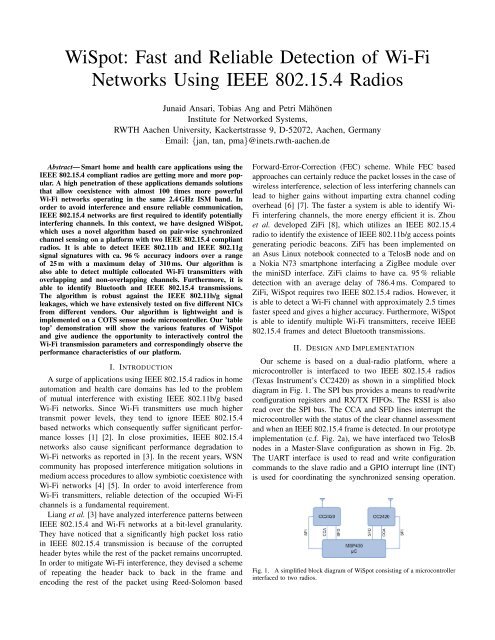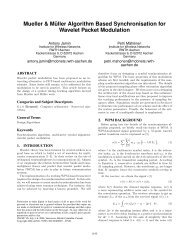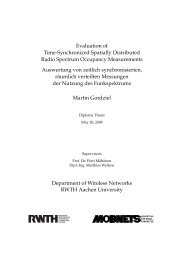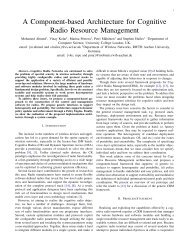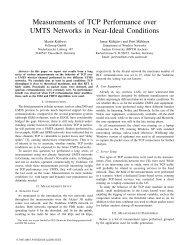WiSpot - iNETS - RWTH Aachen University
WiSpot - iNETS - RWTH Aachen University
WiSpot - iNETS - RWTH Aachen University
Create successful ePaper yourself
Turn your PDF publications into a flip-book with our unique Google optimized e-Paper software.
<strong>WiSpot</strong>: Fast and Reliable Detection of Wi-Fi<br />
Networks Using IEEE 802.15.4 Radios<br />
Junaid Ansari, Tobias Ang and Petri Mähönen<br />
Institute for Networked Systems,<br />
<strong>RWTH</strong> <strong>Aachen</strong> <strong>University</strong>, Kackertstrasse 9, D-52072, <strong>Aachen</strong>, Germany<br />
Email: {jan, tan, pma}@inets.rwth-aachen.de<br />
Abstract— Smart home and health care applications using the<br />
IEEE 802.15.4 compliant radios are getting more and more popular.<br />
A high penetration of these applications demands solutions<br />
that allow coexistence with almost 100 times more powerful<br />
Wi-Fi networks operating in the same 2.4 GHz ISM band. In<br />
order to avoid interference and ensure reliable communication,<br />
IEEE 802.15.4 networks are first required to identify potentially<br />
interfering channels. In this context, we have designed <strong>WiSpot</strong>,<br />
which uses a novel algorithm based on pair-wise synchronized<br />
channel sensing on a platform with two IEEE 802.15.4 compliant<br />
radios. It is able to detect IEEE 802.11b and IEEE 802.11g<br />
signal signatures with ca. 96 % accuracy indoors over a range<br />
of 25 m with a maximum delay of 310 ms. Our algorithm is<br />
also able to detect multiple collocated Wi-Fi transmitters with<br />
overlapping and non-overlapping channels. Furthermore, it is<br />
able to identify Bluetooth and IEEE 802.15.4 transmissions.<br />
The algorithm is robust against the IEEE 802.11b/g signal<br />
leakages, which we have extensively tested on five different NICs<br />
from different vendors. Our algorithm is lightweight and is<br />
implemented on a COTS sensor node microcontroller. Our ’table<br />
top’ demonstration will show the various features of <strong>WiSpot</strong><br />
and give audience the opportunity to interactively control the<br />
Wi-Fi transmission parameters and correspondingly observe the<br />
performance characteristics of our platform.<br />
I. INTRODUCTION<br />
A surge of applications using IEEE 802.15.4 radios in home<br />
automation and health care domains has led to the problem<br />
of mutual interference with existing IEEE 802.11b/g based<br />
Wi-Fi networks. Since Wi-Fi transmitters use much higher<br />
transmit power levels, they tend to ignore IEEE 802.15.4<br />
based networks which consequently suffer significant performance<br />
losses [1] [2]. In close proximities, IEEE 802.15.4<br />
networks also cause significant performance degradation to<br />
Wi-Fi networks as reported in [3]. In the recent years, WSN<br />
community has proposed interference mitigation solutions in<br />
medium access procedures to allow symbiotic coexistence with<br />
Wi-Fi networks [4] [5]. In order to avoid interference from<br />
Wi-Fi transmitters, reliable detection of the occupied Wi-Fi<br />
channels is a fundamental requirement.<br />
Liang et al. [3] have analyzed interference patterns between<br />
IEEE 802.15.4 and Wi-Fi networks at a bit-level granularity.<br />
They have noticed that a significantly high packet loss ratio<br />
in IEEE 802.15.4 transmission is because of the corrupted<br />
header bytes while the rest of the packet remains uncorrupted.<br />
In order to mitigate Wi-Fi interference, they devised a scheme<br />
of repeating the header back to back in the frame and<br />
encoding the rest of the packet using Reed-Solomon based<br />
Forward-Error-Correction (FEC) scheme. While FEC based<br />
approaches can certainly reduce the packet losses in the case of<br />
wireless interference, selection of less interfering channels can<br />
lead to higher gains without imparting extra channel coding<br />
overhead [6] [7]. The faster a system is able to identify Wi-<br />
Fi interfering channels, the more energy efficient it is. Zhou<br />
et al. developed ZiFi [8], which utilizes an IEEE 802.15.4<br />
radio to identify the existence of IEEE 802.11b/g access points<br />
generating periodic beacons. ZiFi has been implemented on<br />
an Asus Linux notebook connected to a TelosB node and on<br />
a Nokia N73 smartphone interfacing a ZigBee module over<br />
the miniSD interface. ZiFi claims to have ca. 95 % reliable<br />
detection with an average delay of 786.4 ms. Compared to<br />
ZiFi, <strong>WiSpot</strong> requires two IEEE 802.15.4 radios. However, it<br />
is able to detect a Wi-Fi channel with approximately 2.5 times<br />
faster speed and gives a higher accuracy. Furthermore, <strong>WiSpot</strong><br />
is able to identify multiple Wi-Fi transmitters, receive IEEE<br />
802.15.4 frames and detect Bluetooth transmissions.<br />
II. DESIGN AND IMPLEMENTATION<br />
Our scheme is based on a dual-radio platform, where a<br />
microcontroller is interfaced to two IEEE 802.15.4 radios<br />
(Texas Instrument’s CC2420) as shown in a simplified block<br />
diagram in Fig. 1. The SPI bus provides a means to read/write<br />
configuration registers and RX/TX FIFOs. The RSSI is also<br />
read over the SPI bus. The CCA and SFD lines interrupt the<br />
microcontroller with the status of the clear channel assessment<br />
and when an IEEE 802.15.4 frame is detected. In our prototype<br />
implementation (c.f. Fig. 2a), we have interfaced two TelosB<br />
nodes in a Master-Slave configuration as shown in Fig. 2b.<br />
The UART interface is used to read and write configuration<br />
commands to the slave radio and a GPIO interrupt line (INT)<br />
is used for coordinating the synchronized sensing operation.<br />
Fig. 1. A simplified block diagram of <strong>WiSpot</strong> consisting of a microcontroller<br />
interfaced to two radios.
(a) Snapshot.<br />
Fig. 2.<br />
(b) Simplified schematics.<br />
<strong>WiSpot</strong> prototype platform.<br />
Through an efficient implementation of the code, we achieve<br />
a speed of 70 µs to read an RSSI sample while 22 µs to<br />
check the status of CCA. Furthermore, <strong>WiSpot</strong> requires a<br />
frequency switching duration of only 740 µs. Our algorithm<br />
uses software controlled CCA threshold and RSSI sample<br />
values for detecting the spectral masks of IEEE 802.11b and<br />
IEEE 802.11g signals. A timeout interval of 160 µs after<br />
detecting simultaneous channel occupancy on the master node<br />
is used to allow an SFD interrupt and hence to recognize an<br />
IEEE 802.15.4 frame.<br />
Our algorithm is computationally simple and relies on<br />
synchronized sensing of the adjacent IEEE 802.15.4 channels<br />
on the two radios. If the channel pair is found to be not<br />
simultaneously occupied, the sensing operation is performed<br />
for a maximum duration of 100 ms, which corresponds to the<br />
Wi-Fi beaconing rate. In order to uniquely detect a particular<br />
Wi-Fi channel, a dual-radio platform requires three sensing<br />
cycles. However, using an elimination method, the sensing<br />
iterations on <strong>WiSpot</strong> are reduced down to 15 for covering the<br />
complete 2.4 GHz spectrum. Once a channel pair is found to<br />
be simultaneously occupied, the mean RSSI values for channel<br />
pair is stored before switching to the next channel pair. The<br />
final analysis is carried out on the master node after scanning<br />
the complete spectrum. In order to identify Wi-Fi channels,<br />
the simultaneous channel occupation result of each sequence<br />
step is compared with the result of the subsequent step until<br />
all the 15 steps in the spectrum sensing sequence have been<br />
compared. The analysis includes finding the leaked signal,<br />
identification of multiple collocated transmitters and conflict<br />
resolution for overlapping Wi-Fi channels in the detection<br />
process. We will describe these algorithmic details during the<br />
demonstration.<br />
III. DEMONSTRATION DESCRIPTION<br />
During the demonstration, we will describe the design<br />
rationale for different aspects of <strong>WiSpot</strong>. We will present the<br />
performance characteristics of <strong>WiSpot</strong> when using only the<br />
RSSI mode and when using the mode with combination of<br />
RSSI and CCA. The detection of IEEE 802.11b and IEEE<br />
802.11g signals 1 based on their spectral masks will be shown.<br />
1 <strong>WiSpot</strong> is able to detect IEEE 802.11n networks only when they are not<br />
using channel bonding, i.e. their bandwidth is confined to 22 MHz like IEEE<br />
802.11b/g networks. In the case of channel bonding (bandwidth of 40 MHz),<br />
the algorithm requires minor modifications.<br />
The robustness of <strong>WiSpot</strong> against out-of-band signal leakages<br />
at short distances on commercially available Wi-Fi transmitters<br />
will also be shown. Furthermore, we would demonstrate the<br />
detection of multiple simultaneous Wi-Fi transmitters, Bluetooth<br />
transmissions and recognition of IEEE 802.15.4 frames.<br />
A WiSpy DBx signal analyzer will be used to observe the live<br />
signal characteristics as a comparison.<br />
We have developed a GUI based visualization tool, which<br />
will allow the audience to interactively set the Wi-Fi channels<br />
and their transmit power levels using both IEEE 802.11b as<br />
well as IEEE 802.11g standards. Furthermore, the tool will<br />
also allow the users to start and stop Bluetooth and IEEE<br />
802.15.4 packet transmissions. The <strong>WiSpot</strong> platforms will be<br />
connected to a PC over the USB interface. The detection<br />
characteristics on the <strong>WiSpot</strong> such as the IEEE 802.11b/g<br />
channel and detection duration, IEEE 802.15.4 frames and<br />
the detection of Bluetooth transmission will be indicated over<br />
the USB interface. Since the detection duration on <strong>WiSpot</strong> is<br />
extremely fast with max. 310 ms detection and classification<br />
delay, the GUI based application will display the absolute as<br />
well as statistical values for various signal detections, their<br />
type and the frequency channels.<br />
The demonstration and related visualizations will be accomplished<br />
in a ’table-top’ fashion with a few <strong>WiSpot</strong> platforms,<br />
IEEE 802.11b/g access points, a WiSpy DBx signal analyzer,<br />
a Bluetooth dongle, a TelosB sensor node platform and a<br />
laptop PC. We will bring all the necessary equipments with<br />
us. The required demonstration setup time is 15-20 minutes.<br />
The demonstration will be enhanced by a poster describing<br />
the schematics, algorithm details and selected performance<br />
evaluation results.<br />
ACKNOWLEDGMENT<br />
We would like to thank partial financial support from DFG<br />
through UMIC Research Centre, and European Union through<br />
FARAMIR and 2PARMA projects.<br />
REFERENCES<br />
[1] S. Y. Shin, H. S. Park, and W. H. Kwon, “Mutual interference analysis<br />
of IEEE 802.15.4 and IEEE 802.11b,” Comput. Netw., vol. 51, pp. 3338–<br />
3353, 2007.<br />
[2] M. Petrova, J. Riihijärvi, P. Mähönen, and S. Labella, “Performance study<br />
of IEEE 802.15.4 using measurements and simulations,” in IEEE Wireless<br />
Communications and Networking Conference, April 2006.<br />
[3] C.-J. M. Liang, N. B. Priyantha, J. Liu, and A. Terzis, “Surviving Wi-Fi<br />
interference in low power ZigBee networks,” in Proc. of ACM SenSys,<br />
2010.<br />
[4] J. Ansari, T. Ang and P. Mähönen, “Spectrum agile medium access control<br />
protocol for wireless sensor networks,” in Proc. of IEEE SECON, 2010.<br />
[5] C. A. Boano, T. Voigt, N. Tsiftes, L. Mottola, K. Roemer, and M. A.<br />
Zuniga, “Making Sensornet MAC Protocols Robust Against Interference,”<br />
in EWSN, 2010.<br />
[6] J. Ansari and P. Mähönen, “Channel selection in spectrum agile and<br />
cognitive MAC protocols for wireless sensor networks,” in Proc. of ACM<br />
MobiWac, 2010.<br />
[7] C. Cormio and K. Chowdhury, “A survey on MAC protocols for cognitive<br />
radio networks,” Ad Hoc Netw., vol. 7, no. 7, pp. 1315–29, 2009.<br />
[8] R. Zhou, Y. Xiong, G. Xing, L. Sun, and J. Ma, “ZiFi: wireless LAN<br />
discovery via ZigBee interference signatures,” in Proc. of ACM MobiCom,<br />
2010.


